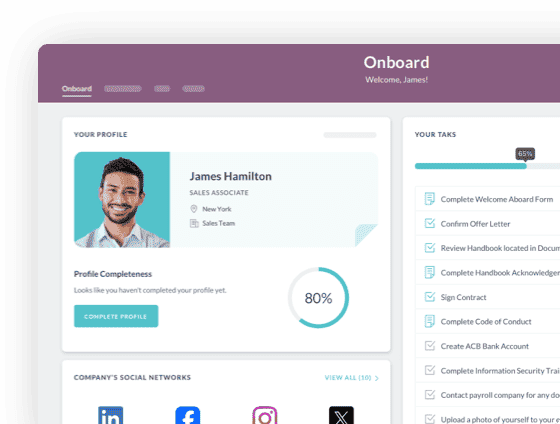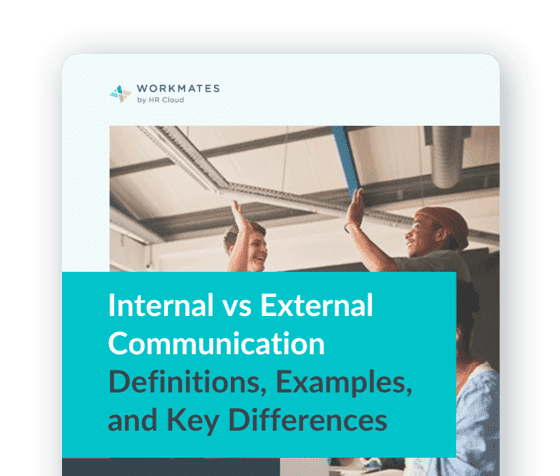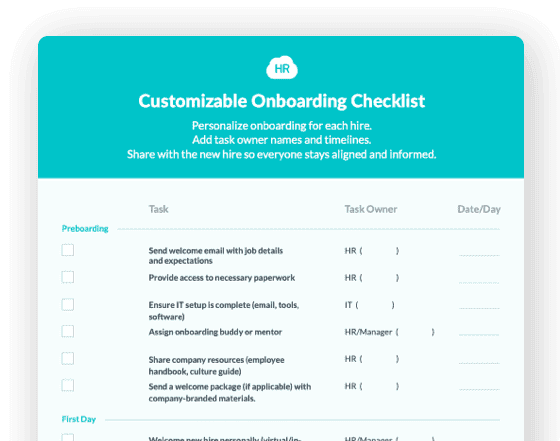Why Workforce Management is Essential For High-Performing Businesses
-1.jpg)


 Cut onboarding time
by 60%—here's the
Ultimate Checklist
that helped do it.
Cut onboarding time
by 60%—here's the
Ultimate Checklist
that helped do it.

The modern workplace has undergone significant changes over the past years. Take the impact of the outbreak of the Corona pandemic as an example. Quarantines and stay-at-home orders forced companies to adopt remote working.
Access to technologies and digitalization made the process a little smoother. But, the HR department had to learn and adapt new strategies to manage employees.
Yet, that is not the only challenge facing HR. The modern workplace is fast-paced and ever-evolving. The teams must overcome recruiting hurdles, workforce management including engagement and development.
The solution to most of the challenges lies in workforce management. But what does it mean?
Exploring Workforce Management
Workforce management is any system that helps with the efficient running of the company. It is a broad term that covers much more than just the people. Any system or process that contributes falls under workforce management.
So why is it an important topic worthy of discussion? Well, the employees are critical to the success of any company. Proper management of such resources is an important priority for many companies.
You know the phrase ‘happy wife/spouse, happy house’ Well, allow us to put a twist on it to read, ‘happy employees, happy employer.’
Now, what happens in a, well, happy work environment? The one answer is higher productivity, which is a win-win for everyone.
As you can imagine, a lot goes into the process. But, we can always look to technology to provide a solution. Forward-looking companies use workforce management software to assist with different tasks.
HR gets help with:-
-
Team scheduling without the use of a spreadsheet. Automation helps with handling workloads, staff availability, vacations, and absences.
-
Clear overview of team workloads
-
Easy assigning of activities resulting in better aligning and prioritization of work
-
Better assigning of responsibilities so no one is over or underworked
-
Centralization of all activities on one dashboard. The result is better planning, management, and monitoring of work processes.
-
Better communication with quick access to data
-
Data security and privacy in compliance with general data protection regulations.
Automation of tasks results in greater efficiency and time-saving. The company can operate with a lean HR team without compromising productivity.
Let's look at why workforce management is critical for business success.
1. Better Employee Experiences
Workforce management removes any confusion. Every employee has clarity on job expectations. There is clear communication across the teams.
Higher transparency will boost employee morale. It is a fantastic way to show the company cares about them.
There is also better aligning of processes with workforce management software. When employees know their roles, there is higher engagement with the work.
HR can also be more proactive in how they deal with the staff. All of these result in a better work environment, thus better employee experiences.
The right workforce management software will help with employee performance management. Measuring factors like employee engagement give excellent insights. The company will, for instance, know what needs to change to increase productivity.
2. Support for Remote Workers
Flexible work environments are the new norm for employers and employees alike. At the outbreak of the pandemic, there wasn't much choice. State enforcement of stay-at-home orders made it necessary.
Yet, with the opening of the economy, many people still prefer to work from home. Indeed, even employers have no problem with the new model.
A 2021 study shows that up to 70% of companies plan to maintain remote working. 58% of employees would rather continue working from home. 97% of workers are willing to adopt a hybrid work model. This does not call for a full-time physical presence in an office.
HR has to overcome the challenge of managing employees wherever they are. Workforce management software brings efficiency to the process. Tasks like those we have highlighted above are easy with the right tools.
HR can, for example, track employee performance without face-to-face interaction. They can also generate forecasts to guide as KPIs. The software will also ease communication, so everyone is up to date.
3. Better Recruit Experiences With Candidate Relationship Management Systems
Recruiting is a major HR challenge. Finding the right candidates can be very difficult. The talent pool is small. Yet, competition for people with the right skill sets is high.
Investing in candidate relationship management systems makes it easy to overcome this hurdle. The tools help with improving and managing current and potential candidate relationships.
Better communication enhances engagement and candidate experiences. The company becomes more attractive to talent. Thus, it will always have a ready pool willing to join.
4. Workforce Management to Gain a Competitive Edge
As we stated, workforce management systems allow for streamlining activities and processes. The organization can adapt to developments or new trends. Data insights help in sound decision-making around critical issues.
The ability to forecast and plan for long-term changes means the company is always ahead. It reduces vulnerabilities that could arise from sudden changes in the labor market.
But that's not all. Some critical Workforce management elements can change the way you do business. These include:-
-
Labor force forecasting uses data to predict future developments and staffing needs. Take the example of peak seasons for the business. With proper forecasting, the company can know beforehand how many people to hire at such a time. The information is critical for budgeting and workload allocation, depending on demand.
-
Scheduling for proper distribution of work to the available staff. It helps in streamlining activities. You will always have the right people handling the right tasks at any given time. Even in times of market changes, the company can adapt. Take the example of a sudden increase in demand. Data-driven insights help with the allocation of the right skill sets to specific tasks.
-
Capacity or workload-to-work force matching to determine staffing capacity. It takes into consideration budget cycles, ad hoc projects, vacations, and absenteeism. In this way, the company can better plan work with the available resources.
-
Traffic management takes into consideration supply and demand. The company can deal with discrepancies arising from resource shifts or staff availability.
Final Thoughts
Workforce management is critical for the smooth operation of the company. This is because it takes care of the most valuable resources. That is the people, process, and systems.
There is better communication, streamlining of activities, and workload balancing. Further, automation increases efficiency, thus higher productivity
Author Bio: This article is written by our marketing team at HR Cloud. HR Cloud is dedicated to providing powerful solutions for your HR teams and creating an exceptional employee experience. Our aim is to help your company improve employee engagement, onboarding, and to save you valuable time!
Keep Reading
The Complete Guide to Remote Work Policy Compliance: Navigating Multi-State Tax, Legal, and Security Requirements in 2026
With 22.9% of US employees working remotely as of Q1 2024—up from 19.6% the previous year
Enterprise HRIS Implementation: Rippling vs HR Cloud Integration Capabilities and Deployment Success
Enterprise HR Software Implementation Comparison
Best Workday Alternatives for Mid-Market Companies in 2026: Complete HRIS Comparison Guide
"We implemented Workday and our HR team still can't figure out half the features six
Like What You Hear?
We'd love to chat with you more about how HR Cloud® can support your business's HR needs. Book Your Free Demo

Build a Culture of Recognition. Boost Engagement. Guaranteed.
Workmates empowers employees to stay informed, connected, and appreciated—whether they’re on the front line, in the office, or remote. Recognition drives 12x higher engagement.Trusted by industry leaders in every sector




Cut Onboarding Costs by 60%.
Take the confusion and follow-ups out of onboarding with automated workflows, digital forms, and structured portals—so new hires ramp faster 3X quicker.Trusted by industry leaders in every sector




